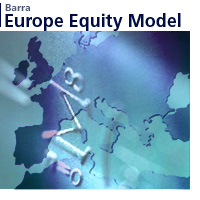The next generation of Europe Equity Models.

The enhanced Barra Europe Equity Model (EUE3) offers portfolio managers and risk analysts a powerful combination of improved accuracy, more flexibility, expanded coverage, and an intuitive structure which they can use to help them construct and manage risk-adjusted portfolios.
Available in six different versions to reflect local and regional commonalities, as well as different investment horizons, the EUE3 model family is designed to be used across a broad range of applications.
Improved Accuracy
By using new and enhanced style factors, a new specific risk model, and considerable technical refinements, EUE3 provides improved portfolio risk forecasts and better explanatory power of common sources of asset returns.
More Flexibility
EUE3 offers three different model versions namely Base, UK derived, and Eastern Europe derived models. The Base version uses a pan-European market factor and a single set of industry factors across Europe, emphasizing regional commonalities. In contrast, the derived versions split the region into two parts by applying separate market and industry factors for the UK and Eastern European countries, respectively. The derived versions offer an extra level of granularity to users who desire to separately budget risk for the UK or Eastern Europe. All models are provided in long-horizon (EUE3L) and short-horizon (EUE3S) variants to cater for users with different investment horizons.
Extensive Coverage
EUE3 extends coverage to 13 new countries, mostly in Eastern Europe. The model now covers around 9,400 stocks in 29 markets, including many Eastern European emerging and frontier markets.
EUE3 can be used by equity portfolio managers to:
- Quantify ex-ante risk, and separate its common-factor and asset-specific sources.
- Construct their optimally-weighted international portfolios, and run pre-trade scenarios.
- Evaluate risk-adjusted performance by identifying drivers of returns and volatility.
- Compute predicted portfolio active risk versus a selected benchmark (tracking error).
- Create portfolios that track indexes with fewer stocks and lower transaction costs.
- Run pre-trade 'what if' scenarios and marginal analysis to evaluate risk/return tradeoffs.
- Develop active 'tilt' strategies using common factors.


